June 12, 2024
Editorial responsibilities : Direction of the collection "Regulations & Compliance", JoRC & Dalloz
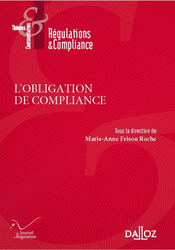
🌐follow Marie-Anne Frison-Roche on LinkedIn
🌐subscribe to the Newsletter MAFR. Regulation, Compliance, Law
____
► Full Reference: M.-A. Frison-Roche (dir.), L'Obligation de Compliance, coll."Régulations & Compliance", Journal of Regulation & Compliance (JoRC) and Dalloz, to be published.
____
📘 At the same time, a book in English, Compliance Obligation, is published in the collection copublished by the Journal of Regulation & Compliance (JoRC) and the Éditions Bruylant.
____
🧮the book follows the cycle of colloquia 2023 organised by the Journal of Regulation & Compliance (JoRC) and its Universities partners.
____
📚this volume is one of a series of books devoted to Compliance in this collection.
► read the presentations of the other books:
- further books:
🕴️M.-A. Frison-Roche (ed.), 📕Le système probatoire de la Compliance, 2025
- previous books:
🕴️M.-A. Frison-Roche & M. Boissavy (eds.), 📕Compliance et droits de la défense. Enquête interne - CJIP - CRPC, 2023
🕴️M.-A. Frison-Roche (ed.), 📕La juridictionnalisation de Compliance, 2023
🕴️M.-A. Frison-Roche (ed.), 📕Les Buts Monumentaux de la Compliance, 2022
🕴️M.-A. Frison-Roche (ed.), 📕Les outils de la Compliance, 2021
🕴️M.-A. Frison-Roche (ed.), 📕Pour une Europe de la Compliance, 2019
🕴️N. Borga, 🕴️J.-Cl. Marin and 🕴️J.-Ch. Roda (eds.), 📕Compliance : l'Entreprise, le Régulateur et le Juge, 2018
🕴️M.-A. Frison-Roche (ed.), 📕Régulation, Supervision, Compliance, 2017
🕴️M.-A. Frison-Roche (ed.), 📕Internet, espace d'interrégulation, 2016
📚see the global presentation of all the books of the collection.
___
► General presentation of this book: Compliance is sometimes presented as an inescapable mechanism , which is tantamount to seeing it as the legal Obligation par excellence, Criminal Law being its most appropriate mode of expression. But this is not so obvious. Moreover, it is becoming difficult to unify all Compliance Tools, which encompass moral representations of the world, and even cultures specific to each company, so that Law can only produce incentives or produce soft law. As a result, Compliance Obligation appears as very difficult to define.
These hesitations reflect the youth of this Compliance Law under construction. Identified through juxtaposed special laws, for each of which specialists have come forward, it is nonetheless taking shape with its own normativity, anchored in its Monumental Goals. Because the notion of Obligation is as old as Law itself, the Obligation of Compliance is confronted with all the branches of Law, and more particularly, with all due respect, with Contract and Tort Law.
But Compliance has long been a practice, effectiveness, efficacy and efficiency being among its principles. How can all these ambitious declarations be put into effect? Is there not a hint of a gap between the grandiloquence of this declared Compliance Obligation and what actually happens? The practical question of how to compel is, in this new branch of Law, a question of law.
In order to have a more accurate perception of the Obligation of Compliance and therefore to better measure its future, it is advisable to end up taking its Advanced Point, which is the Obligation of Vigilance, clearer and stronger than the other instruments, having Monumental Goals, placing the Judge more clearly at the centre, developing in an already more visible way the power of this Obligation of Compliance which abstracts itself as necessary from borders and claims to express sovereignties.
____
🏗️general construction of this Book: The book opens with a double Introduction. The first, which is freely accessible, consists of a summary of the book, while the second, which is substantial, deals with the unified conception that we can, and indeed should, have, of the "Compliance Obligation", without losing the concrete and active character that characterises this branch of law.
The first Part of the book aims to define the Compliance Obligation. To this end, Chapter I deals with the Nature of this obligation. Chapter II deals with the Spaces of the Compliance Obligation.
The Part II aims to articulate the Compliance Obligation with other branches of Law.
The Part III of the book looks at the way in which the possibility of obliging and the means of obliging are provided. To this end, Chapter I deals with the Convergence of the Sources of the Compliance Obligation. Chapter II considers International Arbitration as a reinforcement of the Compliance Obligation. To this end, Chapter I deals with the Convergence of the Sources of the Compliance Obligation. Chapter II considers International Arbitration as a reinforcement of the Compliance Obligation.
The last Part of the book is devoted to Vigilance, the leading edge of the Compliance Obligation. Chapter I is devoted to a study of the various sectors, and analyses the Intensities of the Vigilance Obligation. Chapter II deals with the Variations in Tension generated by the Vigilance Obligation. Finally, Chapter III deals with the New Modalities of the Compliance Obligation, highlighted by the Vigilance Imperative.
____
TABLE OF CONTENTS
L’OBLIGATION DE COMPLIANCE : VISION D’ENSEMBLE
(COMPLIANCE OBLIGATION : OVERVIEW)
Section 1 ♦️ Lignes de force de l’ouvrage L'Obligation de Compliance (Main Aspects of the Book L'Obligation de Compliance), by 🕴️Marie-Anne Frison-Roche
Section 2 ♦️ Concevoir l’unicité de l’Obligation de Compliance sans la diluer (Conceiving the unicity of the Compliance Obligation without diluting it), by 🕴️Marie-Anne Frison-Roche
TITRE I.
CERNER L’OBLIGATION DE COMPLIANCE
(IDENTIFYING THE COMPLIANCE OBLIGATION)
CHAPITRE I : LA NATURE DE L’OBLIGATION DE COMPLIANCE
(CHAPTER I: THE NATURE OF THE COMPLIANCE OBLIGATION)
Section 1 ♦️ La Volonté, le Cœur et le Calcul (Will, Heart and Calculation), by 🕴️Marie-Anne Frison-Roche
Section 2 ♦️ La dette, notion économique comme fondement de l'Obligation de Compliance (Debt, an economic concept underpinning the Compliance Obligation), by 🕴️Bruno Deffains
Section 3 ♦️ Obligation de Compliance et droits humains (Compliance Obligation and Human Rights), by 🕴️Jean-Baptiste Racine
Section 4 ♦️ Les mutations de la souveraineté et l'Obligation de Compliance (Changes in Sovereignty and the Compliance Obligation), by 🕴️René Sève
CHAPITRE II : LES ESPACES DE L’OBLIGATION DE COMPLIANCE (SPACES OF THE COMPLIANCE OBLIGATION)
Section 1 ♦️ Entités industrielles et Obligation de Compliance (Industrial entities and Compliance Obligation), by 🕴️Etienne Maclouf
Section 2 ♦️ L'Obligation de Compliance dans les chaînes de valeur (The Compliance Obligation in Value Chains), by 🕴️Lucien Rapp
Section 3 ♦️ Compliance et conflits de lois. Le droit international de la vigilance-conformité (Compliance and conflict of laws. International Law of Vigilance-Conformity), by 🕴️Louis d'Avout
TITRE II.
ARTICULER L’OBLIGATION DE COMPLIANCE AVEC DES BRANCHES DU DROIT
(ARTICULATING THE COMPLIANCE OBLIGATION WITH BRANCHES OF LAW)
Section 1 ♦️ Dimensions constitutionnelles de l'Obligation de Compliance (Constitutional dimensions of the Compliance Obligation), by 🕴️Stéphane Mouton
Section 2 ♦️ Droit fiscal et Obligation de Compliance (Tax Law and Compliance Obligation), by 🕴️Daniel Gutmann
Section 3 ♦️ Le droit processuel, prototype de l'Obligation de Compliance (General Procedural Law, prototype of the Compliance Obligation), by 🕴️Marie-Anne Frison-Roche
Section 4 ♦️ Le droit des sociétés et des marchés financiers face à l'Obligation de Compliance (Corporate and Financial Markets Law facing the Compliance Obligation), by 🕴️Anne-Valérie Le Fur
Section 5 ♦️ Le rapport entre le Droit de la responsabilité civile et l'Obligation de Compliance (The link between Tort Law and Compliance Obligation), by 🕴️Jean-Sébastien Borghetti
Section 6 ♦️ Dimensions environnementales et climatiques de l'Obligation de Compliance (Environmental and Climatic Dimensions of the Compliance Obligation), by 🕴️Marta Torre-Schaub
Section 7 ♦️ Droit de la concurrence et Droit de la Compliance (Competition Law and Compliance Law), by 🕴️Jean-Christophe Roda
Section 8 ♦️ L'Obligation de Compliance en Droit global (The Compliance Obligation in Global Law), by 🕴️Benoît Frydman & 🕴️Alice Briegleb
Section 9 ♦️ Transformation des relations de travail et obligation de vigilance (Transformation of Labour Relations and Vigilance Obligation), by 🕴️Stéphane Vernac
Section 11 ♦️ Juge du droit des entreprises en difficulté et obligations de compliance (Judge of Insolvency Law and Compliance Obligations), by 🕴️Jean-Baptiste Barbièri
TITRE III.
COMPLIANCE : DONNER ET SE DONNER LES MOYENS D’OBLIGER
(COMPLIANCE : GIVE AND TAKE THE MEANS TO OBLIGE)
CHAPITRE I : LA CONVERGENCE DES SOURCES (CONVERGENCE OF SOURCES)
Section 1 ♦️ L’Obligation de Compliance, entre volonté et consentement : obligation sur obligation vaut (Compliance Obligation, between Will and Consent: obligation upon obligation works), by 🕴️Marie-Anne Frison-Roche
Section 2 ♦️ Ce qu'est un engagement (What a Commitment is), by 🕴️Marie-Anne Frison-Roche
Section 3 ♦️ Les technologies disponibles, prescrites ou proscrites pour satisfaire Compliance et Vigilance (Technologies available, prescribed or prohibited to meet Compliance and Vigilance requirements), by 🕴️Emmanuel Netter
Section 4 ♦️ La cybersécurité et l’Obligation de Compliance (Cybersecurity and Compliance Obligation), by 🕴️Michel Séjean
Section 5 ♦️ La place de l’espoir dans l’aptitude à appréhender l’avenir (The Place of Hope in the Ability to Apprehend the Future), by 🕴️
Section 6 ♦️ Contrainte légale et stratégie des entreprises en matière de Compliance (Legal Constraint and Company Strategies in Compliance matters), by 🕴️Jean-Philippe Denis & Nathalie Fabbe-Costes
Section 7 ♦️ La loi, source de l’Obligation de Compliance (The law, source of the Compliance Obligation), by 🕴️Jean-Baptiste Blanc
Section 8 ♦️ Opposition ou convergence des systèmes juridiques dans les règles et cultures de compliance (Opposition or Convergence of Legal Systems in Compliance Rules and Cultures), by 🕴️Raphaël Gauvain & 🕴️Blanche Balian
CHAPITRE II : L’ARBITRAGE INTERNATIONAL EN RENFORT DE L’OBLIGATION DE COMPLIANCE (INTERNATIONAL ARBITRATION IN SUPPORT OF THE COMPLIANCE OBLIGATION)
Section 1 ♦️ Le renforcement des engagements de Compliance par le renvoi Ex Ante à l’arbitrage international (Reinforcing Compliance Commitments by referring Ex Ante to International Arbitration"), by
Section 2 ♦️ La condamnation en nature par le tribunal arbitral, renfort de l’Obligation de Compliance (The Arbitral Tribunal's Award in Kind, in support of the Compliance Obligation), by 🕴️Eduardo Silva Romero
Section 3 ♦️ L’usage de l’arbitrage international pour renforcer l’obligation de Compliance : l’exemple du secteur de la construction (The use of International Arbitration to reinforce the Compliance Obligation: the example of the construction sector), by 🕴️Christophe Lapp & 🕴️Jean-François Guillemin
Section 4 ♦️ L’arbitre, juge, superviseur, accompagnateur ? (The Arbitrator, Judge, Supervisor, Support) , by 🕴️Jean-Baptiste Racine
Section 5 ♦️ L’arbitre, organe indirect et direct de l’Obligation de Compliance ? (The Arbitrator, indirect and direct agent of the Compliance Obligation?), by 🕴️Laurent Aynès
TITRE IV.
LA VIGILANCE, POINTE AVANCÉE DE L’OBLIGATION DE COMPLIANCE
(VIGILANCE, SPEARHEAD OF THE COMPLIANCE OBLIGATION)
CHAPITRE I : LES INTENSITÉS DE L’OBLIGATION DE VIGILANCE, POINTE AVANCÉE DU SYSTÈME DE COMPLIANCE (INTENSITIES OF THE VIGILANCE OBLIGATION, SPEARHEAD OF THE COMPLIANCE SYSTEM)
Section 1 ♦️ Articulation systémique entre Vigilance, Due Diligence, conformité et Compliance : la Vigilance, part totale de l'Obligation de Compliance (Systemic Articulation between Vigilance, Due Diligence, Conformity and Compliance: Vigilance, Total Share of the Compliance Obligation), by 🕴️Marie-Anne Frison-Roche
Section 2 ♦️ L’intensité de l’Obligation de Vigilance selon les secteurs : le cas des opérateurs financiers (Intensity of the Vigilance Obligation by Sectors: the case of Financial Operators), by 🕴️Anne-Claire Rouaud
Section 3 ♦️ L’intensité de l’Obligation de Vigilance selon les secteurs : le cas des opérateurs bancaires et d’assurance (Intensity of the Vigilance Obligation by Sectors: the case of Banking and Insurance Operators), by 🕴️Mathieu Françon
Section 4 ♦️ L’intensité de l’Obligation de Vigilance selon les secteurs : le cas des opérateurs numériques (Intensity of the Vigilance Obligation by Sectors: the case of Digital Operators), by 🕴️Grégoire Loiseau
Section 5 ♦️ L’intensité de l’Obligation de Vigilance selon les secteurs : le cas des opérateurs énergétiques (Intensity of the Vigilance Obligation by Sectors: the case of Energy Operators), by 🕴️Marie Lamoureux
CHAPITRE II : LES VARIATIONS DE TENSIONS ENGENDRÉES PAR L’OBLIGATION DE VIGILANCE, POINTE AVANCÉE DU SYSTÈME DE COMPLIANCE (VARIATIONS OF TENSIONS GENERATED BY THE VIGILANCE OBLIGATION, SPEARHEAD OF THE COMPLIANCE SYSTEM)
Section 1 ♦️ Repenser le concept de responsabilité civile à l’aune du devoir de vigilance, pointe avancée de la compliance (Rethinking the Concept of Civil Liability in the light of the Duty of Vigilance, Spearhead of Compliance), by 🕴️Mustapha Mekki
Section 2 ♦️ Transformation de la gouvernance et obligation de Vigilance (Transformation of Governance and Vigilance Obligation), by 🕴️Véronique Magnier
CHAPITRE III : LES MODALITÉS NOUVELLES DE L'OBLIGATION DE COMPLIANCE, MISES EN LUMIÈRE PAR L'IMPÉRATIF DE VIGILANCE (NEW MODALITIES OF THE COMPLIANCE OBLIGATION, HIGHLIGHTED BY THE VIGILANCE IMPERATIVE)
Section 1 ♦️ La façon dont l'impératif de Vigilance s'ajuste aux règles juridiques internationales (How the Vigilance Imperative fits in with International Legal Rules), by 🕴️Bernard Haftel
Section 2 ♦️ Contrats et clauses, mise en œuvre et modalités de l’Obligation de Vigilance (Contracts and clauses, implementation and modalities of the Vigilance Obligation), by 🕴️Gilles J. Martin
Section 3 ♦️ La preuve de la bonne exécution de la Vigilance au regard du système probatoire de Compliance (Proof that Vigilance has been properly carried out with regard to the Compliance Evidence System), by 🕴️Jean-Christophe Roda
TITRE V.
LE JUGE ET L'OBLIGATION DE COMPLIANCE
(THE JUDGE AND THE COMPLIANCE OBLIGATION)
Section 1 ♦️ Les enjeux présents à venir de l’articulation des principes de procédure civile et commerciale avec la logique de compliance (Present and Future Challenges of Articulating Principles of Civil and Commercial Procedure with the Logic of Compliance), by 🕴️Thibault Goujon-Bethan
Section 2 ♦️ La médiation, voie d'avenir pour une Obligation de Compliance effective (Mediation, the way forward for an Effective Compliance Obligation), by 🕴️Malik Chapuis
Section 3 ♦️ Le Juge requis pour une Obligation de Compliance effective (The Judge required for an Effective Compliance Obligation), by 🕴️Marie-Anne Frison-Roche
________
Feb. 29, 2024
Editorial responsibilities : Direction of the collection "Regulations & Compliance", JoRC & Dalloz
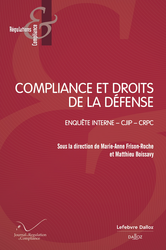
🌐follow Marie-Anne Frison-Roche on LinkedIn
🌐subscribe to the Newsletter MAFR Regulation, Compliance, Law
____
► Full Reference: M.-A. Frison-Roche & M. Boissavy (eds.), Compliance et droits de la défense. Enquête interne – CJIP – CRPC (Compliance and rights of the defence. Internal investigation – French Judicial Public Interest Agreement – French guilty plea procedure), Journal of Regulation & Compliance (JoRC) and Dalloz, "Régulations & Compliance" Serie, 2024, 362 p.
____
► General presentation of the book: We do not have an overall view of the relationship between Compliance and the rights of the defence in the continuum of internal investigations and DPA, or in the French legal system the convention judiciaire d'intérêt public (CJIP) and the comparution immédiate avec reconnaissance de culpabilité (CRPC), in particular because the texts, whether hard law or soft law, decisions and academic analyses segment them, making it difficult to build a pertinent appreciation of each one. This is made all the more difficult by the fact that we know little about how each of them is applied in practice, both within each of them and in relation to each other. As a result, it is difficult to express overall satisfaction, or total rejection, or to suggest some specific reforms and to precise on what points, to identify the appropriate source of these improvements, legislation, case law, professions, or spontaneous ways of doing. The first ambition of this book is therefore to restore an overall vision, because this is the vision of practice. If shortcomings are found to exist, then they can be more easily denounced.
However, some of the situations described may be described as flawed, or even dramatic, by some, while others may consider that they should be approved as they stand. This applies, for example, to the question of whether or not the investigation report should be secret from the prosecuting authority, which may propose a DPA (or in the French legal system a CJIP), whether or not this CJIP should be extended to individuals, whether or not a lawyer should be present from the internal investigation stage onwards, whether or not the lawyer should support the interests of the company he/she is investigating and continue to do so before the regulator or the prosecutor, whether or not the investigation is delegated from the public authorities to the company, whether or not the lawyer-investigator and then the lawyer-defendant are both lawyers, whether or not the victims are represented in the the CIPC process, etc. Depending on what one thinks the relation between Compliance and due process should be in principle and in practice, one expresses a more or less approving or severe judgement on the state of the texts, the soft law nature of most of them making the exercise complicated, and then if there is a gap between them and what one thinks should be the right standard, one asserts that in practice things happen differently from what the texts say, or one considers that the texts should be changed. From point to point, a veritable kaleidoscope emerges in this book.
Indeed, the result is a series of contributions that sometimes clash with one another, with a sort of contradictionary principle creeping into the very structure of this book, thus establishing the readesr as a sort of judges themselves , that character who is so absent. He/she will be able to do so, since the book lists texts, describes practices and gives an illustration of everything that can be thought of, in visions that are sometimes analytical and sometimes global, with proposals of reforms of texts, jurisprudence or conduct.
The aim of the book is to enable readers to form their own opinions and to take part in what is undoubtedly being strongly debated today: the confrontation between Compliance and rights of the defence.
____
🧮this book follows a conference organised by the Conseil national des barreaux - CNB (French National Council of Lawyers), which took place on 20 and 21 April 2023: Avocats et droits de la défense dans les enquêtes internes et la justice négociée.
____
This volume is the continuation of the books dedicated to Compliance in this collection.
📚 Read the presentations of the other books on Compliance in this collection:
- further books:
🕴️M.-A. Frison-Roche (ed.), 📕Le système probatoire de la compliance, 2025
🕴️M.-A. Frison-Roche (ed.), 📕Compliance et contrat, 2024
🕴️M.-A. Frison-Roche (ed.), 📕L'Obligation de Compliance, 2024
- previous books:
🕴️M.-A. Frison-Roche (dir.), 📕La juridictionnalisation de la Compliance, 2023
🕴️M.-A. Frison-Roche (ed.), 📕Les Buts Monumentaux de la Compliance, 2022
🕴️M.-A. Frison-Roche (ed.), 📕Les outils de la Compliance, 2021
🕴️M.-A. Frison-Roche (ed.), 📕Pour une Europe de la Compliance, 2019
🕴️N. Borga, N., 🕴️J.-Cl. Marin & 🕴️J.-Ch. Roda (eds.), 📕Compliance : Entreprise, Régulateur, Juge, 2018
🕴️M.-A. Frison-Roche (ed.), 📕Régulation, Supervision, Compliance, 2017
🕴️M.-A. Frison-Roche (ed.), 📕Internet, espace d'interrégulation, 2016
📚Read the presentations of the other titles of the collection.
____
► Summary of the book: The rights of the defence are one of the pillars of our Rule of Law. On the face of it, compliance techniques are not concerned with this under the pretext of efficiency. This would be particularly true in a trilogy that unfolds over time: internal investigation, convention judiciaire d'intérêt public - CJIP (French Judicial Public Interest Agreement) and comparution sur reconnaissance préalable de culpabilité - CRPC (French guilty plea procedure).
However, because Compliance Law is also the expression of the Rule of Law, in that its ambition is to detect and prevent systemic risks in order to protect present and future human beings, we must go beyond this opposition and articulate Compliance and rights of the defence.
The Monumental Goals of Compliance, which justify its power, for example to obtain information, and the fundamental rights of the defence, which for example impose the presumption of innocence, must be adjusted to each other; by interpreting texts, or even adopting new ones.
The book analyses each of these three techniques, in particular the still largely unregulated internal investigation, and sheds light on them in relation to each other, in order to formulate proposals.
____
🏗️General construction of the book: The book opens with an overview divided into three sections. The first Title compares the challenges of the internal investigation with the rights of the defence. The second Title compares the issues at stake in the convention judiciaire d'intérêt public - CJIP (French Judicial Public Interest Agreement) and the comparution sur reconnaissance préalable de culpabilité - CRPC (French guilty plea procedure) with these same rights of the defence.
____
TABLE OF CONTENTS
COMPLIANCE ET DROITS DE LA DÉFENSE : VISION D'ENSEMBLE
(COMPLIANCE AND RIGHTS OF THE DEFENCE : OVERVIEW)
Section 2 ♦️ Compliance et droits de la défense : toujours pour le respect des droits humains (Compliance and rights of the defence: always for the respect of human rights), by🕴️Matthieu Boissavy
Section 3 ♦️ Circuler dans le temps pour mettre en phase Compliance et droits de la défense (Moving through Time to align Compliance and rights of the defence), by🕴️Marie-Anne Frison-Roche
TITRE I.
LES ENJEUX PROCÉDURAUX DE L'ENQUETE INTERNE CONFRONTÉE AUX DROITS DE LA DÉFENSE
(TITLE I.
PROCEDURAL CHALLENGES OF THE INTERNAL INVESTIGATION
IN RELATION TO THE RIGHTS OF THE DEFENCE)
CHAPITRE I : VISION GÉNÉRALE DES DROITS DE LA DÉFENSE DANS L'ENQUÊTE INTERNE
(CHAPTER I: OVERVIEW OF THE RIGHTS OF THE DEFENCE IN INTERNAL INVESTIGATION)
Section 1 ♦️ Approche doctrinale de l’enquête interne et de l’enquête pénale privée (Doctrinal approach to internal investigation and private criminal investigation), by 🕴️Benjamin Fiorini
Section 2 ♦️ Regard critique : La place des droits de la défense dans l'enquête interne selon le guide AFA/PNF (A critical look: The place of the rights of the defence in the internal investigation according to the AFA/PNF Guide), by 🕴️Margaux Durand-Poincloux, 🕴️David Apelbaum and 🕴️Paola Sardi-Antasan
CHAPITRE II : LES DROITS DE LA DÉFENSE À CHAQUE ÉTAPE DE L'ENQUÊTE INTERNE
(CHAPTER II: THE RIGHTS OF THE DEFENCE AT EACH STAGE OF THE INTERNAL INVESTIGATION)
Section 1 ♦️ La réception des alertes par l'avocat (Reception of alerts by the lawyer), by🕴️Maria Lancri
Section 2 ♦️ Collecte et traitement des informations dans les enquêtes internes à l'ère numérique : processus et enjeux (Collecting and processing information for internal investigations in the digital age: processes and challenges), by🕴️Uriel Goldberg
Section 3 ♦️ L’apport de la psychologie pour l'effectivité des droits de la défense dans l'enquête interne pour harcèlement au travail (The contribution of psychology to the effectiveness of the rights of the defence in internal investigation for harassment in the workplace), by🕴️Nathalie Leroy & 🕴️Danièle Zucker
Section 4 ♦️ Le respect des droits de la défense lors des auditions des enquêtes internes : un gage d’efficacité (Respecting the rights of the defence during hearings in internal investigations: a guarantee of efficacy), by 🕴️Emmanuel Daoud & 🕴️Ghita Khalid Rouissi
Section 5 ♦️ L’enquête interne au cœur des enjeux de conformité et de justice négociée : analyse de la position de l'AFA et du PNF (The internal investigation at the heart of conformity and negotiated justice issues: analysis of the position of the AFA and the PNF), by🕴️Éric Russo
Section 6 ♦️ Le rapport d’enquête interne à l’épreuve des droits de la défense (The internal investigation report put to the test of defence rights), by🕴️Samuel Sauphanor
CHAPITRE III : LA SPÉCIFICITÉ DES ENQUÊTES INTERNES DANS LES ENTREPRISES INTERNATIONALES ET LA PLACE DES DROITS DE LA DÉFENSE
(CHAPTER III : SPECIFICITY OF INTERNAL INVESTIGATIONS IN INTERNATIONAL COMPANIES AND THE PLACE OF THE RIGHTS OF THE DEFENCE)
Section 1 ♦️ La spécificité des enquêtes internes pratiquées par les groupes internationaux (Specificity of internal investigations carried out by international groups), by 🕴️Olivier Catherine
Section 2 ♦️ Garantir la valeur probatoire d’un rapport dans le cadre d’une enquête interne opérée dans une entreprise internationale (Guaranteeing the evidential value of a report in an internal investigation carried out in an international company), by 🕴️Monique Figueiredo
Section 3 ♦️ La responsabilité de l'entreprise dans la conception et la menée de l'enquête interne (The company's responsibility in designing and conducting an internal investigation), by 🕴️Lydia Meziani
Section 4 ♦️ Enquêtes internes, enquêtes pénales et droits de la défense : que nous disent les jurisprudences américaine et anglaise (l’affaire Connolly et l’affaire ENRC) ? (Internal investigations, criminal investigations and rights of the defence: what do the US and UK case law tell us (the Connolly case and the ENRC case)?), by 🕴️Victoire Chatelin
CHAPITRE IV : LE RÔLE SINGULIER DE L'AVOCAT DANS L'ENQUÊTE INTERNE
(CHAPTER IV: THE SPECIAL ROLE OF THE LAWYER IN THE INTERNAL INVESTIGATION)
Section 1 ♦️ La méthodologie propre à l'avocat enquêteur (The investigating lawyer's own methodology), by 🕴️William Feugère
Section 2 ♦️ L'enquête interne façonnée par la déontologie de l'avocat (The internal investigation shaped by the lawyer's deontology), by 🕴️Stéphane De Navacelle, 🕴️Julie Zorrila and 🕴️Laura Ragazzi
Section 3 ♦️ Préserver le secret professionnel de l'avocat dans l'enquête interne et son résultat (Preserving the lawyer's professional secrecy in the internal investigation and its outcome), by 🕴️Bénédicte Graulle & 🕴️Yanis Rahim
Section 4 ♦️ L’avocat-enquêteur en droit du travail : un janséniste au milieu du Far West (The lawyer-investigator in employment law: a Jansenist in the Wild West), by 🕴️Richard Doudet
Section 5 ♦️ La défense des personnes physiques dans les enquêtes internes (Defending individuals in internal investigations), by 🕴️Dorothée Hever
TITRE II.
LES ENJEUX PROCÉDURAUX DE LA CJIP ET DE LA CRPC
CONFRONTÉES AUX DROITS DE LA DÉFENSE
(TITLE II.
PROCEDURAL CHALLENGES OF THE FRENCH JUDICIAL PUBLIC INTEREST AGREEMENT
AND THE FRENCH GUILTY PLEA PROCEDURE
IN RELATION TO THE RIGHTS OF THE DEFENCE)
CHAPITRE I : VISION GÉNÉRALE DES DROITS DE LA DÉFENSE DANS LA CJIP ET LA CRPC
(CHAPTER I: OVERVIEW OF THE RIGHTS OF THE DEFENCE IN THE FRENCH JUDICIAL PUBLIC INTEREST AGREEMENT AND THE FRENCH GUILTY PLEA PROCEDURE)
Section 1 ♦️ Théorie et pratique de la négociation dans la justice pénale (Theory and practice of negotiation in criminal justice), by 🕴️Sarah-Marie Cabon
Section 2 ♦️ La lutte anti-corruption : l’emprunt au modèle américain et à ses récentes évolutions (The fight against corruption: borrowing from the American model and its recent developments), by 🕴️Stephen L. Dreyfuss
Section 3 ♦️ Justice pénale négociée : avantages présents, risques à venir (Negotiated criminal justice: curent benefits, future risks), by 🕴️Alexis Bavitot
CHAPITRE II : FORMES ACTIVES DES DROITS DE LA DÉFENSE, LES DIALOGUES À L'OEUVRE OU À PARFAIRE DANS LA CJIP ET LA CRPC
(CHAPTER II: ACTIVE FORMS OF THE RIGHTS OF THE DEFENCE, DIALOGUES AT WORK OR TO BE PERFECTED IN THE FRENCH JUDICIAL PUBLIC INTEREST AGREEMENT AND THE FRENCH GUILTY PLEA PROCEDURE)
Section 1 ♦️ Combinaison des CRPC et des CJIP : le cas particulier des affaires de fraude fiscale (Combination of the French guilty plea procedure and the French Judicial Public Interest Agreement: the special issue of tax fraud cases), by 🕴️Marion David
Section 2 ♦️ Pour une justice pénale négociée plus équitable (For a fairer negotiated criminal justice), by🕴️Astrid Mignon Colombet
Section 3 ♦️ Les impacts, sur les droits de la défense, des disparités de la justice pénale négociée dans l’Union européenne (The impact on the rights of the defence of the disparities in negotiated criminal justice in the European Union), by 🕴️Emmanuel Moyne
Section 4 ♦️ L'évolution des rapports entre avocats et autorités de poursuites depuis l'introduction de la CJIP (Developments in relations between lawyers and prosecuting authorities since the introduction of the French Judicial Public Interest Agreement), by 🕴️Thomas Baudesson
CHAPITRE III : LE RÔLE SINGULIER DE L'AVOCAT DANS LA CJIP ET LA CRPC
(CHAPTER III: THE SINGULAR ROLE OF THE LAWYER IN THE FRENCH JUDICIAL PUBLIC INTEREST AGREEMENT AND THE FRENCH GUILTY PLEA PROCEDURE)
Section 1 ♦️ Quand se justifie et quand s'arrête la collaboration ? À propos de la CJIP (When is collaboration justified and when does it end? About the French Judicial Public Interest Agreement), by 🕴️Philippe Goossens
Section 2 ♦️ Le dialogue de l’avocat et de son client, chef d’entreprise, face à la proposition d’une CRPC et d’une CJIP (The dialogue between the lawyer and his client, a company director, faced with the proposal of a French guilty plea procedure or a French Judicial Public Interest Agreement), by 🕴️François Saint-Pierre
Section 3 ♦️ Le dilemme de l'avocat pénaliste face à la CRPC (The criminal lawyer's dilemma when faced with the French guilty plea procedure), by 🕴️Jean Boudot
Section 5 ♦️ Défendre les intérêts des victimes dans la justice pénale économique négociée (Defending victims' interests in negotiated economic criminal justice), by 🕴️Jérôme Karsenti
________
Jan. 26, 2024
Editorial responsibilities : Direction of the collection Compliance & Regulation, JoRC and Bruylant
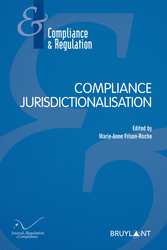
🌐follow Marie-Anne Frison-Roche on LinkedIn
🌐subscribe to the Newsletter MAFR Regulation, Compliance, Law
____
► Full Reference: M.-A. Frison-Roche (ed.), Compliance Jurisdictionalisation, Journal of Regulation & Compliance (JoRC) and Bruylant, "Compliance & Regulation" Serie, 2024, 464 p.
____
📕In parallel, the French version of this book, La juridictionnalisation de la Compliance, is published in the collection co-published by the Journal of Regulation & Compliance (JoRC) and Dalloz
____
🧮This book comes after a cycle of colloquia organised in 2021 by the Journal of Regulation & Compliance (JoRC) and its Academic Partners
____
► General presentation of the book: Sanctions, controls, appeals, deals: judges and lawyers are everywhere in the Compliance mechanisms, creating unprecedented situations, sometimes without a solution yet available. Even though Compliance was designed to avoid the judge and produce security by avoiding conflict. This jurisdictionalisation is therefore new. Forcing companies to prosecute and judge, a constrained role, perhaps against their nature. Leading to the adaptation of major procedural principles, with difficulty. Confronting arbitration with new perspectives. Putting the judge at heart, in mechanisms designed so that he is not there. How in practice to organize these opposites and anticipate the solutions? This is the challenge taken up by this book.
____
This volume is the continuation of the books dedicated to Compliance in this collection.
📚Read the presentation of the other books of this collection:
- further books:
🕴️M.-A. Frison-Roche (ed.), 📘Compliance Obligation, 2024
- previous books:
🕴️M.-A. Frison-Roche (ed.), 📘Compliance Monumental Goals, 2023
🕴️M.-A. Frison-Roche (ed.), 📘Compliance Tools, 2021
____
► Summary of the book: There have always been Judges and Lawyers in Compliance Law, in particular because this branch of Law is an extension of Regulatory Law in which they have a core place. This results from the fact that the decisions taken in respect of Compliance are contestable in Court, including Arbitration, those issued by the Company, such as those of States or Authorities, the Judge in turn becoming what Compliance Law is effective.
The novelty lies more in the phenomenon of "jurisdictionalisation", that is to say that the trial model penetrates all Compliance Law, and not only the Ex Post part that it includes. Moreover, it seems that this jurisdictionalisation influences the non-legal dimension of Compliance. This movement has effects that must be measured and causes that must be understood. Advantages and disadvantages that must be balanced. If only to form an opinion vis-à-vis Companies that have become Prosecutors and Judges of themselves and others ...: encourage this "Jurisdictionalisation of Compliance", fight it, perhaps influence it? In any case, understand it!
____
🏗️General construction of the book:
The book opens with a double Introduction. The first, which is freely accessible, consists of a summary of the book, while the second, which is substantial, deals with the need to bring the Judge and the Lawyer into line if Compliance Law is to be the hallmark of States governed by the Rule of Law.
The first Chapter is devoted to what is specific to Compliance Law: the transformation of companies into Prosecutors and Judges of themselves, and even of others.
The second Chapter examines the interference between General Procedural Law and Compliance techniques.
The third Chapter measures the influence of the reasoning and requirements of Compliance Law in methods of dispute resolution where it has not, with a few exceptions, been present, but where it has a great future: arbitration.
Because trials and judgements are indissociable, because legal techniques and the Rule of Law must not be dissociated, and because Compliance techniques could paradoxically be the weapon used to dissociate them, because the power to judge and the procedures surrounding it must not be dissociated, because Compliance and the Rule of Law must therefore be conceived and practised together, the rise in power of one being a sign of the rise in power of the other, and not the price of the weakening of the Rule of Law, the fourth Chapter deals with the role of the Judge in Compliance.
____
► Understand the book through the table of contents below and the summaries of each article :
DOUBLE INTRODUCTION
🕴️M.-A. Frison-Roche, 📝Main Aspects of the book Compliance Jurisdictionalisation
🕴️M.-A. Frison-Roche, 📝Reinforce the Judge and the Lawyer to impose Compliance Law as a characteristic of the Rule of Law
I. THE COMPANY ESTABLISHED PROSECUTOR AND JUDGE OF ITSELF BY COMPLIANCE LAW
🕴️M.-A. Frison-Roche, 📝The "Judge-Judged". Articulating Words and Things in the face of Conflicts of Interest
🕴️C. Granier, 📝Reflections on the existence of companies’ jurisprudence through Compliance matters
🕴️L.-M. Augagneur, 📝The jurisdictionalisation of reputation by platforms
🕴️A. Bruneau, 📝The compagny judges itself: the Compliance function in the bank
🕴️J.-M. Coulon, 📝Compliance Law in the construction industry and the contradictions, impossibilities and. deadlocks that companies face
🕴️Ch. Lapp, 📝Compliance in companies: the statues of process
🕴️J. Heymann, 📝The Legal Nature of the Facebook "Supreme Court"
🕴️D. Latour, 📝Internal investigations within companies
🕴️A. Bavitot, 📝Shaping the company through negotiated Criminal Justice Agreements. French perspective
🕴️S. Merabet, 📝Vigilance, being a judge and not judge
II. PROCEDURAL LAW IN COMPLIANCE LAW
🕴️N. Cayrol, 📝Procedural Principles in Compliance Law
🕴️F. Ancel, 📝Compliance Law, a new guiding principle for the Trial?
🕴️B. Sillaman, 📝Taking the Compliance U.S. Procedural Experience globally
🕴️S. Scemla, & 🕴️D. Paillot, 📝The difficulty for Compliance Enforcement Authorities to comprehend the Rights of the Defence in compliance matters
🕴️M.-A. Frison-Roche, 📝Adjusting General Procedural Law to Compliance Law by the nature of things
III. ARTICULATION BETWEEN COMPLIANCE LAW AND INTERNATIONAL ARBITRATION
🕴️J.-B. Racine, 📝Compliance and arbitration. An attempt at problematisation
🕴️E. Silva-Romero & 🕴️R. Legru, 📝What place is there for compliance in investment arbitration?
🕴️M. Audit, 📝The arbitrator's position on compliance
🕴️E. Kleiman, 📝The objectives of compliance confronted with the actors of arbitration
IV. THE JUDGE IN COMPLIANCE LAW
🕴️M.-A. Frison-Roche, 📝The Judge, the Compliance Obligation and the Company. The Compliance Evidence System
🕴️J. Morel-Maroger, 📝The application of compliance standards by European Union judges
🕴️S. Schiller, 📝A single judge in the event of an international breach of compliance obligations?
🕴️O. Douvreleur, 📝Compliance and Judge of the Law
🕴️F. Raynaud, 📝The Administrative Judge and Compliance
🕴️E. Wennerström, 📝Some Reflections on Compliance and the European Court of Human Rights
________
Nov. 15, 2023
Editorial responsibilities : Direction of the collection "Cours-Série Droit privé", Editions Dalloz (33)
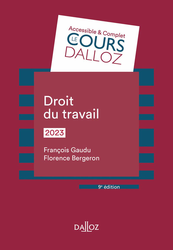
► Référence générale : F. Gaudu et F. Bergeron-Canut, Droit du travail, Dalloz, coll. "Cours Dalloz-Série Droit privé", 10ième éd., 2024, 686 p.
____
► Présentation de l'ouvrage : Ce manuel à jour des derniers textes s'adresse à tous les étudiants en droit et à tous les praticiens qui actualisent leurs connaissances.
Il développe dans une première partie les " relations individuelles de travail " (formation du rapport contractuel, exécution et rupture du contrat de travail), pour consacrer sa seconde partie aux " relations collectives de travail ", (conflits collectifs du travail, représentation et la négociation collective et convention collective de travail).
____
►dans la même collection, consulter les Cours complémentaires de celui-ci :
🕴️F. Kessler 📕 Droit de la protection sociale.
🕴️S. Piedelièvre,V. Magnier, 📕Droit des sociétés
____
📚Consulter l'ensemble de la collection dans laquelle le Cours est publié.
________
Oct. 4, 2023
Editorial responsibilities : Direction of the collection "Cours-Série Droit privé", Editions Dalloz (33)
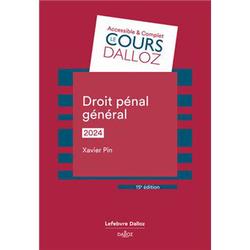
► Référence complète : X. Pin, Droit pénal général, Dalloz, Coll. "Cours Dalloz-Série Droit privé", 15ième éd., 2024, 722 p.
____
► La nouvelle édition pour 2024 de cet ouvrage à jour des dernières réformes, aborde dans un premier temps la "loi pénale", dans sa détermination et dans son application, puis dans un deuxième temps l'ouvrage aborde "l'infraction" avec sa qualification et son imputation pour finir dans une troisième partie sur "la peine", en distinguant entre la peine encourue, la peine prononcée et la peine exécutée.
____
► Voir dans la collection les ouvrages qui s'articulent avec celui-ci :
____
📚Consulter l'ensemble de la collection dans laquelle cet ouvrage est publié.
________
Feb. 2, 2023
Editorial responsibilities : Direction of the collection "Regulations & Compliance", JoRC & Dalloz
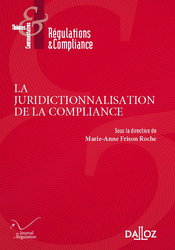
♾️ follow Marie-Anne Frison-Roche on LinkedIn
♾️ subscribe to the Newsletter MAFR Regulation, Compliance, Law
____
► Full Reference: M.-A. Frison-Roche (ed.), La juridictionnalisation de la Compliance, série "Régulations & Compliance", Journal of Regulation & Compliance (JoRC) and Dalloz, 2023, 500 p.
____
► This book in few words: Sanctions, controls, appeals, deals: judges and lawyers are everywhere in the Compliance mechanisms, creating unprecedented situations, sometimes without a solution yet available. Even though Compliance was designed to avoid the judge and produce security by avoiding conflict. This jurisdictionalisation is therefore new. Forcing companies to prosecute and judge, a constrained role, perhaps against their nature. Leading to the adaptation of major procedural principles, with difficulty. Confronting arbitration with new perspectives. Putting the judge at heart, in mechanisms designed so that he is not there. How in practice to organize these opposites and anticipate the solutions? This is the challenge taken up by this book.
____
📘 In parallel, the English version of this book, Compliance Jurisdictionalisation, is published in the series co-published by the Journal of Regulation & Compliance (JoRC) and Bruylant.
____
📅 This book comes after a cycle of colloquia organised in 2021 by the Journal of Regulation & Compliance (JoRC) and its Academic Partners.
____
This volume is the continuation of the books dedicated to Compliance in this collection.
► Read the presentations of the other books on Compliance in this collection:
- further books:
🕴️M.A. Frison-Roche (ed.), 📕Le système probatoire de la compliance, 2025
🕴️M.A. Frison-Roche (ed.), 📕L'obligation de compliance, 2024
🕴️M.A. Frison-Roche et M. Boissavy (ed.), 📕Compliance & droits de la défense. Enquête interne - CJIP - CRPC, 2023
- previous books :
🕴️Frison-Roche, M.-A. (ed.), 📕 Les buts monumentaux de la Compliance, 2022
🕴️Frison-Roche, M.-A. (ed.), 📕 Les outils de la Compliance, 2020
🕴️Frison-Roche, M.-A. (ed.), 📕 Pour une Europe de la Compliance, 2019
🕴️N. Borga, N., 🕴️J.-Cl. Marin & 🕴️J.-Ch. Roda (ed.), 📕 Compliance : Entreprise, Régulateur, Juge, 2018
🕴️Frison-Roche, M.-A. (ed.), 📕 Régulation, Supervision, Compliance, 2017
🕴️Frison-Roche, M.-A. (ed.), 📕 Internet, espace d'interrégulation, 2016
📕 Read the presentations of the other titles of the collection.
____
► General presentation of the book: There have always been Judges and Lawyers in Compliance Law, because this branch of Law is an extension of Regulatory Law in which they have a core place. This results from the fact that the decisions taken in respect of Compliance are contestable in Court, including Arbitration, those issued by the Company, such as those of States or Authorities, the Judge in turn becoming what Compliance Law is effective.
The novelty lies more in the phenomenon of "jurisdictionalisation", that is the trial model penetrates all Compliance Law, and not only the Ex-Post part that it includes. Moreover, it seems that this jurisdictionalisation influences the non-legal dimension of Compliance. This movement has effects that must be measured and causes that must be understood. Advantages and disadvantages that must be balanced. If only to form an opinion vis-à-vis Companies that have become Prosecutors and Judges of themselves and others ...: encourage this "Jurisdictionalisation of Compliance", fight it, perhaps influence it? In any case, understand it!
___
🏗️ General construction of this book:
The book begins by a double Introduction, the first (in free access) summarizing the book, the second, substantial, relating to the need to reinforce the Judge and the Lawyer to impose the Compliance Law as a characteristic of the Rule of Law.
The first Part is devoted to what is specific to Compliance Law. of Compliance: the transformation of companies into Prosecutors and Judges of themselves, even of others.
The second Part relates to Compliance general procedural Law, the procedure being the way between the dispute and the judgement.
The third Part continues this journey to the judge and aims to measure the influence of the reasoning and requirements of Compliance Law in dispute resolution methods where it was not, with some exceptions, present, but where it has a great future: Arbitration.
Because trial and judicial decision are inseparable, because legal techniques and the Rule of Law should not be divided but compliance techniques could paradoxically be the weapon of their dissociation, because the power to judge and the procedures surrounding the latter must not be dissociated, because therefore Compliance mechanisms and the Rule of Law must be thought out and practiced then, the rise in power of one must be the sign of the rise in power of the other, and not the price of the 'weakening of the Rule of Law, the fourth Part relates to the Judges in the Compliance mechanisms and culture.
____
DOUBLE INTRODUCTION
🕴️M.-A. Frison-Roche, 📝Lignes de force de l'ouvrage La juridictionnalisation de la Compliance free access to the full text
🕴️M.A. Frison-Roche, 📝Conforter le rôle du Juge et de l'Avocat pour imposer la Compliance comme caractéristique de l'État de Droit
I. L'ENTREPRISE INSTITUÉE PROCUREUR ET JUGE D'ELLE-MEME ET D'AUTRUI PAR LE DROIT DE LA COMPLIANCE ("THE COMPANY ESTABLISHED PROSECUTOR AND JUDGE OF ITSELF AND OTHERS BY COMPLIANCE LAW")
🕴️M.-A. Frison-Roche,📝 Le "jugeant-jugé". Articuler les mots et les choses face à l'éprouvant conflit d'intérêts
🕴️C. Granier, 📝Réflexions sur l'existence d'une jurisprudence des entreprises
🕴️L.-M. Augagneur, 📝La juridictionnalisation de la réputation par les plateformes
🕴️A. Bruneau, 📝L'entreprise juge d'elle-même : la fonction compliance dans la banque
🕴️Lapp, Ch., 📝La compliance dans l'entreprise : les statuts du process
🕴️J. Heymann, 📝La nature juridique de la "Cour suprême" de Facebook
🕴️D. Latour, 📝Les enquêtes internes au sein des entreprises
🕴️A. Bavitot, 📝Le façonnage de l'entreprise par les accords de justice pénale négociée
🕴️S. Merabet, 📝La vigilance, être juge et ne pas juger
II. LE DROIT PROCESSUEL À L'OEUVRE DANS LE DROIT DE LA COMPLIANCE ("GENERAL PROCEDURAL LAW IN COMPLIANCE LAW")
🕴️N. Cayrol, 📝Des principes processuels en Droit de la Compliance
🕴️F. Ancel,📝Le principe processuel de compliance, un nouveau principe directeur du procès ?
🕴️B. Sillaman, 📝Secret professionnel et coopération : les leçons de procédure tirées de l’expérience américaine pour une application universelle
🕴️S. Scemla,🕴️D. Paillot, 📝La difficile appréhension des droits de la défense par les autorités de contrôle en matière de compliance
🕴️M.-A. Frison-Roche, 📝Ajuster par la nature des choses du Droit processuel au Droit de la Compliance
III. L'ARTICULATION DE LA COMPLIANCE ET DE L'ARBITRAGE INTERNATIONAL ("ARTICULATION BETWEEN COMPLIANCE LAW AND INTERNATIONAL ARBITRATION")
🕴️J.-B. Racine, 📝Compliance et Arbitrage. Essai de problématisation
🕴️E. Silva-Romero,🕴️R. Legru, 📝Quelle place pour la Compliance dans l'arbitrage d'investissement ?
🕴️C. Kessedjian, 📝L'arbitrage au service de la lutte contre la violation des droits de la personne humaine par les entreprises
🕴️M. Audit, 📝La position de l'arbitre en matière de compliance
🕴️J. Jourdan-Marques, 📝L’arbitre, juge ex ante de la compliance ?
🕴️E. Kleiman, 📝Les objectifs de la compliance confrontés aux acteurs de l’arbitrage
🕴️F.-X. Train, 📝Arbitrage et procédure parallèles exercées au titre de la compliance
🕴️Cl. Debourg, 📝La compliance au stade du contrôle des sentences arbitrales
IV. LE JUGE DANS LE DROIT DE LA COMPLIANCE ("THE JUDGE IN COMPLIANCE LAW")
🕴️M.-A. Frison-Roche, 📝Le juge, l'obligation de compliance et l'entreprise. Le système probatoire de la Compliance
🕴️J. Morel-Maroger, 📝La réception des normes de la compliance par les juges de l'Union européenne
🕴️S. Schiller, 📝Un juge unique en cas de manquement international à des obligations de compliance ?
🕴️O. Douvreleur, 📝Compliance et juge du droit
🕴️F. Raynaud, 📝Le juge administratif et la compliance
🕴️E. Wennerström, 📝Quelques réflexions sur la Compliance et la Cour européenne des droits de l'Homme
________
Oct. 27, 2022
Editorial responsibilities : Direction of the collection "Cours-Série Droit privé", Editions Dalloz (33)
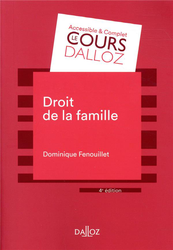
► Référence complète : D. Fenouillet, Droit de la famille, Coll. "Cours Dalloz-Série Droit privé", Dalloz, 1ière éd., 1997, 5ième éd., 2022, 673 p.
____
► Ce manuel à jour des derniers textes s'adresse à tous les étudiants en droit et à tous les praticiens qui actualisent leurs connaissances en droit de la famille.
Il traite dans une première partie des « couples », (marié, démariés, hors mariage), pour consacrer sa deuxième partie à « l'enfant », (rattachement et statut).
Enfin, il finit par développer dans une dernière partie sur « la famille au-delà », (nom, obligation alimentaire et patrimoine de la famille).
____
Consulter l'ensemble de la collection dans laquelle l'ouvrage a été publié.
May 18, 2022
Editorial responsibilities : Direction of the collection "Cours-Série Droit privé", Editions Dalloz (33)
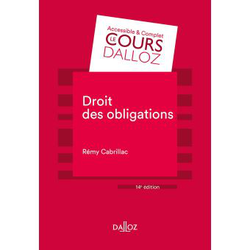
►Référence complète : Cabrillac, R., Droit des obligations, Coll. "Cours Dalloz-Série Droit privé", 15ième éd., 2022, Dalloz, 450 p.
____
►Présentation de l'ouvrage : parfaitement à jour des réformes récentes, le manuel de Rémy Cabrillac raconte en 450 pages le droit des obligations comme une matière vivante et quotidienne. Afin que cette matière demeure compréhensible, sa présentation en demeure classique, une première partie de l'ouvrage est consacré aux sources, la seconde traitant du régime.
Pour le faire, cet ouvrage désormais classique expose ainsi les ates juridiques, les quasi-contrats, la responsabilité civile extracontractuelle, puis les modalités, la circulation et l'extinction des obligations.
____
Consulter l'ensemble de la collection dans laquelle l'ouvrage a été publié.
__________
Feb. 7, 2022
Editorial responsibilities : Direction of the collection "Cours-Série Droit privé", Editions Dalloz (33)
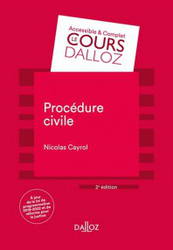
►Référence complète : Cayrol, N., Procédure civile, 4ième éd., Coll. "Cours Dalloz-Série Droit privé", Dalloz, 2022, 569 p.
____
►Présentation de l'ouvrage : L'étude de la procédure civile est indispensable à tous les étudiants désireux d'embrasser une « carrière judiciaire » : magistrat, avocat, huissier, etc. Par nombre d'aspects, la procédure civile est bien, en effet, un droit professionnel, un droit à l'usage des professionnels du procès. La matière figure d'ailleurs aux épreuves des concours et examens d'accès à ces professions.
Mais la procédure civile n'est pas seulement un droit professionnel : elle traite de problèmes qui intéressent tous les juristes, quels qu'ils soient, qu'ils pratiquent ou non la procédure. La connaissance des notions procédurales de base est nécessaire pour la bonne compréhension de nombreuses questions de droit.
____
Lire la quatrième de couverture.
____
📚Voir l'ensemble des ouvrages de la même collection "Cours Dalloz -Série Droit privé", créée et dirigée par Marie-Anne Frison-Roche,
et notamment ceux qui traitent des branches du Droit interférant avec la Procédure civile :
📕 Procédures civiles d'exécution
📕 Institutions juridictionnelles
_______
Feb. 7, 2022
Editorial responsibilities : Direction of the collection "Cours-Série Droit privé", Editions Dalloz (33)

►Référence complète : Cayrol, N., Procédure civile, 4ième éd., Coll. "Cours Dalloz-Série Droit privé", Dalloz, 2022, 569 p.
____
►Présentation de l'ouvrage : L'étude de la procédure civile est indispensable à tous les étudiants désireux d'embrasser une « carrière judiciaire » : magistrat, avocat, huissier, etc. Par nombre d'aspects, la procédure civile est bien, en effet, un droit professionnel, un droit à l'usage des professionnels du procès. La matière figure d'ailleurs aux épreuves des concours et examens d'accès à ces professions.
Mais la procédure civile n'est pas seulement un droit professionnel : elle traite de problèmes qui intéressent tous les juristes, quels qu'ils soient, qu'ils pratiquent ou non la procédure. La connaissance des notions procédurales de base est nécessaire pour la bonne compréhension de nombreuses questions de droit.
____
Lire la quatrième de couverture.
____
📚Voir l'ensemble des ouvrages de la même collection "Cours Dalloz -Série Droit privé", créée et dirigée par Marie-Anne Frison-Roche,
et notamment ceux qui traitent des branches du Droit interférant avec la Procédure civile :
📕 Procédures civiles d'exécution
📕 Institutions juridictionnelles
_______
Sept. 15, 2021
Editorial responsibilities : Direction of the collection "Cours-Série Droit privé", Editions Dalloz (33)
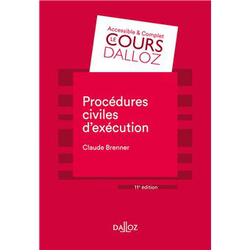
► Référence complète : Brenner, Cl., Procédure civiles d'exécution, Coll. "Cours Dalloz-Série Droit privé", Dalloz, 1ière éd., 1998, 11ième éd., 2021, 278 p.
____
►Présentation de l'ouvrage : Dans la 11ième édition de ce manuel à jour de la réforme du droit des sûretés, Claude Brenner expose les règles relatives aux procédures civiles d'exécution en tant qu'elles sont le complément du Droit des obligations, puisqu'elles rendent effectif l'effet obligatoire des contrats et la responsabilité des personnes.
A jour de toutes les réformes successives, ce manuel permet de comprendre l'ensemble de la manière, dans ses règles communes et dans les procédures spécifiques qui s'y sont développées.
L'ouvrage est construit en deux titres, le premier traitant des procédures d'exécution, le second traitant des procédures de distribution.
____
📚Consulter l'ensemble de la collection dans laquelle l'ouvrage a été publié.
________
Sept. 8, 2021
Editorial responsibilities : Direction of the collection "Cours-Série Droit privé", Editions Dalloz (33)
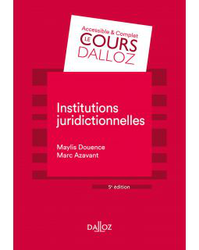
► Référence complète : Douence, M., et Azavant, M., Institutions juridictionnelles, 1ière éd. 2010, 5ième éd. 2021, Coll. "Cours Dalloz-Série Droit privé", Dalloz, 2019, 425 p.
____
►Présentation de l'ouvrage : La nouvelle édition de cet ouvrage expose les "Institutions juridictionnelles", expression qui a remplacé heureusement celle "d'Institutions judiciaires", c'est-à-dire les principes, les structures et les personnes qui permettent la réalisation de la mission de trancher les litiges et de dire le droit. Sont ainsi analysés la justice administrative et judiciaire, les juridictions et les acteurs que sont les magistrats et les auxiliaires de justice, notamment les avocats.
L'ouvrage est destiné aux étudiants et à ceux qui préparent des concours administratifs ou par exemple l'examen d'entrée aux Écoles de formation des Barreaux.
____
📚 Dans la même collection, il s'articule avec les ouvrages de :
____
► Lire la 4ième de couverture.
📚 Voir l'ensemble des ouvrages de la même collection 📎"Cours Dalloz -Série Droit privé"
________
Sept. 8, 2021
Editorial responsibilities : Direction of the collection "Cours-Série Droit privé", Editions Dalloz (33)
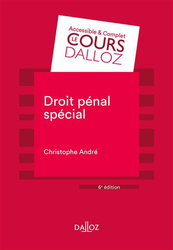
► Référence complète : André, Ch., Droit pénal spécial, Coll. "Cours Dalloz - Série Droit privé", Dalloz, 1ière éd., 2010, 6ième éd., 2021, 594 p.
____
►Présentation de l'ouvrage : La 6ième édition de ce Cours est à jour des réformes qui continuellement modifient les infractions pénales, notamment en matière économique et financière mais aussi sociales (par exemple les "gilets jaunes"), montrant avant tout la constante de la crise d'un droit pénal déliquescent et désormais éclaté en droits répressifs spéciaux. Aujourd'hui c'est non seulement un droit pénal spécial mais encore voire avant tout un droit pénal d'exceptions (ce qui pose problème au regard du droit pénal général, lequel est indissociable de la procédure pénal) qu'il faut apprendre, étudiants comme praticiens.
Ce Cours est construit en trois parties.
La première traite des infractions contre les personnes ; la deuxième des infractions contre les biens ; la troisième contres la Nation, l'État et la paix publique.
Les éléments de procédure pénale, indissociables du droit pénal, sont expliqués à chaque infraction explicitée.
____
Lire la quatrième de couverture.
Voir l'ensemble des ouvrages de la même collection 📚 "Cours Dalloz -Série Droit privé"
et notamment
_____
June 23, 2021
Editorial responsibilities : Direction of the collection "Cours-Série Droit privé", Editions Dalloz (33)

► Référence complète : MARAIS, Astrid, Droit des personnes, Coll. "Cours Dalloz-Série Droit privé", Dalloz, 4ième éd. 2021, 250 p.
📝 Lire la 4ième de couverture.
Depuis la première édition de son ouvrage, la professeure Astrid Marais débute la présentation de celui-ci ainsi : "Tout est chose ou personne".
À partir de ce principe essentiel, le manuel décrit comment le droit détermine les deux catégories de personnes : les personnes physiques et les personnes morales, comme il les individualise et comment il les protège. Le souci des personnes physiques est d'autant plus grand aujourd'hui que le droit prend en considération le corps des êtres humains.
C'est notamment pourquoi l'ouvrage expose le "Droit des personnes" à travers les diverses branches du Droit, désormais toutes concernées par celles-ci.
____
📚Consulter l'ensemble de la collection dans laquelle l'ouvrage a été publié.
June 2, 2021
Editorial responsibilities : Direction of the collection Compliance & Regulation, JoRC and Bruylant
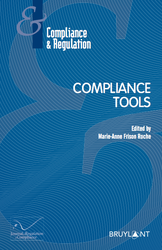
► Full Reference: Frison-Roche, M.-A. (ed.), Compliance Tools, series "Régulations & Compliance", Journal of Regulation & Compliance (JoRC) & Bruylant, 2021.
This book in English is the first title of this collection integrally dedicated to Compliance Law, in that it is the extension of Regulation Law.
____
📚 Read the titles of this series in English co-published by Bruylant.
📚 This collection in English is articulated with a collection co-published between the Journal of Regulation & Compliance and Dalloz.
📕Thus, in parallel, a book in French, Les Outils de la Compliance is published.
___
📅 This book is published after a cycle of colloquiums organised by the Journal of Regulation & Compliance (JoRC) and Partners Universities.
___
► General Presentation of the collective book: The political dimension of Compliance Law lies in the goals it aims to achieve. To achieve them, the concern for these goals is internalized in "crucial operators", which may be obliged to concretize "monumental goals" set by public authorities. These public bodies control the Ex Ante reorganization that this implies for these companies and sanction Ex Post the possible inadequacy of the companies, which have become transparent to this end. The effectiveness and efficiency of this internalization, without which the statement of these goals is worth nothing, is based on the Compliance tools that are deployed.
These appear to be very diverse but their substantial unity (topic which will be the subject of a forthcoming book) makes it possible to study the tools put in place from a unique perspective, by not isolating them in a particular branch of Law, Criminal law or International Law for example, but by measuring what is common to them, notably Anticipation, Trust, Commitment, Responsibility, Incentive, and so on. If the Compliance tools vary, it is rather not only according to the sectors, finance and banking appearing then as the advanced point of the general Compliance Law, for example in environmental matters, but also according to the countries and the cultures. It is in fact about them that legal cultures seem to oppose.
The book aims to understand these "tools" by going beyond the description of each instrument, for which we already have many monographs, for analyzing them through the issues of Risks, required Expertises, Training. Sovereignty claims, Incentives, mechanical aptitude of Technologies. It is through these themes that are analyzed by the authors, experts in the field, what we always want to understand better: Compliance Programs, Whistle blowing, Mapping, Sanctions, Extraterritoriality, etc.
____
Read the summary of the book.
Read the foreword, summarizing all the contributions.
Présentation of the book contributions:
📝Amico, Th., Compliance or the passage from ex post to ex ante: A Copernican revolution for the criminal lawyer?
📝Banck, A., The maturity of the Compliance tool’s user, first criterion of the choice of the salient tool
📝Burlingame, Coppens R., Power, N, Lee, D.H., Anti-Corruption Compliance: Global Dimension of Enforcement and Risk Management
📝Calandri, L., Incentive(s) and Self-Regulation(s): which place for Compliance Law in the Audiovisual Sector?
📝Causse, H., Compliance Training: Through and Beyond Traditional Legal Training
📝Frison-Roche, M.-A., Describing, designing and correlating Compliance Tools to have a better use of it
📝Frison-Roche, M.-A., Building by Law the Unicity of Compliance Tools from the Definition of Compliance Law by its "Monumental Goals"
📝Frison-Roche, M.-A., Drawing up Risk Maps as an obligation and the paradox of the "Compliance risks"
📝 Frison-Roche, M.-A., Incentives and Compliance, a couple to propel
📝 Frison-Roche, M.-A., Resolving the contradiction between sanctions and incentives under the fire of Compliance Law
📝 Frison-Roche, M.-A., Rights, primary and natural Compliance tools
📝 Frison-Roche, M.-A., Training: content and container of Compliance Law
📝 Galland, M., The Regulator's Inspection of the Effectiveness of the Compliance Tools Implemented by the Company
📝 Granier, C., The Normative Originality of Compliance by Design
📝 Guillaume, N., Compliance risk mapping: first insights of challenges, limits and good practices
📝Guttierez-Crespin, A., Audit of Compliance Systems
📝 Koenigsberg, S. and Barrière, F., The Development of Attorney's Compliance Expertise
📝 Larouer, M., The Manifestation of Incentives Mechanisms in French Compliance Law
📝 Merabet, S., Morality by Design
📝 Pailler, L., Technological Tools, Compliance by Design and GDPR: the Protection of Personal Data from Design
📝 Racine, J.-B., Geographical dominance in the choice and the use of Compliance Tools. Introductory remarks
📝Rapp, L., Incentive Theory and Governance of Space Activities
📝 Roda, J.-C., Compliance by design in antitrust: between innovation and illusion
📝 Salah, M., Conception and Application of Compliance in Africa
📝 Tardieu, H., Data Sovereignty and Compliance
📝 Thouret, T., Training and Compliance, Two Correlated Information Transmission Tools
March 18, 2021
Editorial responsibilities : Direction of the collection "Cours-Série Droit privé", Editions Dalloz (33)
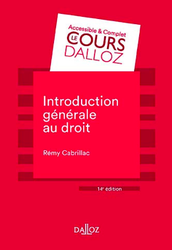
► Référence complète : R. Cabrillac, Introduction générale au droit, 1ière éd. 1995 - 15ième éd., 2023, Dalloz, Coll. "Cours Dalloz-Série Droit privé", 293 p.
____
Le droit est réputé complexe, voire rébarbatif. Pour dépasser cette impression, qui ne correspond pas à sa nature, cet ouvrage, résolument pédagogique, s’adressent aux étudiants qui prennent contact pour la première fois avec la matière.
Il décrit tout d’abord les fondements du droit, ses origines et ses classifications puis il expose les sources du droit, les preuves et le procès.
Il est complété par des tests de connaissances.
____
Jan. 29, 2020
Editorial responsibilities : Direction of the collection "Cours-Série Droit privé", Editions Dalloz (33)
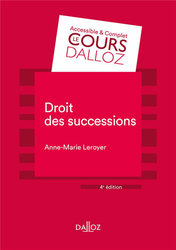
Référence complète : LEROYER, Anne-Marie, Droit des successions, Coll. "Cours Dalloz-Série Droit privé", Dalloz, 4ième éd., 2020, 526 p.
Consulter la 4ième de couverture.
Consulter la table des matières.
May 29, 2019
Editorial responsibilities : Direction of the collection "Regulations & Compliance", JoRC & Dalloz
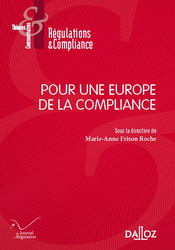
♾️ follow Marie-Anne Frison-Roche on LinkedIn
♾️ subscribe to the Newsletter MAFR Regulation, Compliance, Law
____
► Full Reference: M.-A. Frison-Roche (ed.), Pour une Europe de la Compliance (For the Europe of the Compliance), series "Régulations & Compliance", Dalloz, 2019, 124 p.
____
This volume is the continuation of the books dedicated to Compliance in this collection.
📚Read the other books' presentations of the collection about Compliance:
🕴️M.-A. Frison-Roche (ed.), 📕La juridictionnalisation de la Compliance, 2023
🕴️M.-A. Frison-Roche (ed.), 📕Les Buts Monumentaux de la Compliance, 2022
🕴️M.-A. Frison-Roche (ed.), 📕Les outils de la Compliance, 2021
🕴️N. Borga, 🕴️J.-Cl. Marin &🕴️J.-Ch. Roda (ed.), 📕Compliance : l'Entreprise, le Régulateur et le Juge, 2018
🕴️M.-A. Frison-Roche (ed.), 📕Régulation, Supervision, Compliance, 2017
🕴️M.-A. Frison-Roche (ed.),📕 Internet, espace d'interrégulation, 2016
📚Read the presentations of the other titles of the collection.
____
► General presentation of the book: This book is written in French. The topic is : "For the Europe of the Compliance".
See below its general presentation in English.
The political dimension is intrinsic to the Compliance Law. Indeed, compliance mechanisms consist of internalizing in certains companies the obligation to implement goals of general interest set by Public Authorities. These public bodies control the Ex Ante reorganization that implies for these companies and punish Ex Post the possible structural inadequacy of these compagnies, becoming transparent for this purpose.
This new mode of governance establishes a continuum between Regulation, Supervision, Compliance (book published in 2017) and renew the links between Companies, Regulators and Judges!footnote-1600.
This political dimension must be increased: the Compliance Law of Compliance must today be used to build Europe.
One can observe not only the construction of the European Compliance Law, object-by-object, sector-by-sector, purpose-by-purpose, but also the construction of the European Compliance Law that transcends and unifies them. Becoming independent of American Law and ceasing to be in reaction, even on the defensive, the Compliance Law contributes to the European project, offering it a higher ambition, that Europe can carry and, by this way, can carry the Europe itself, not only to preserve the European economy from corruption or money laundering, but by claiming the protection of nature and human beings.
This is why the book describes the "reasons and objectives" of the Europe of the Compliance, which makes it possible to describe, detect and even predict the ways and means.
____
► Understand the book through the Table of Contents and the summaries of each article:
🕴️M.-A. Frison-Roche, 📝Avant propos
🕴️K. Lenaerts, 📝Le juge de l'Union européenne dans une Europe de la compliance
🕴️M.-A. Frison-Roche, 📝Un droit substantiel de la compliance, appuyé sur la tradition européenne humaniste
I. LES RAISONS ET LES OBJECTIFS D'UNE EUROPE DE LA COMPLIANCE (THE REASONS AND OBJECTIVES OF THE EUROPE OF THE COMPLIANCE)
🕴️X. Musca, 📝Construire une Europe de la compliance en donnant une meilleure place aux entreprises
🕴️P. Vimont, 📝La place de la diplomatie dans l'avancée d'une Europe de la compliance
🕴️P. Sellal, 📝Les vertus de la compliance : une réponse possible aux faiblesses de l'Union européenne ?
🕴️J.-J. Daigre, 📝Compliance, entreprise et Europe
II. LES VOIES ET MOYENS D'UNE EUROPE DE LA COMPLIANCE (THE WAYS AND MEANS OF THE EUROPE OF THE COMPLIANCE)
🕴️J.-Cl. Marin, 📝Quels outils pour la construction du droit de la compliance en Europe ?
🕴️M. Canto-Sperber, 📝La compliance et les définitions traditionnelles de la vertu
🕴️T. Bonneau, 📝Compliance et secteur bancaire et financier en Europe
🕴️C. Duchaine, 📝L'Agence française anticorruption, à l'appui de l'Europe de la compliance
🕴️D. Martin, 📝Les contraintes et les vertus de la compliance
🕴️A. de La Cotardière, 📝Construire une Europe de la compliance lisible pour les entreprises
________
Jan. 16, 2019
Editorial responsibilities : Direction of the collection "Cours-Série Droit privé", Editions Dalloz (33)
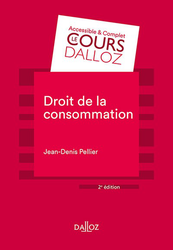
Référence générale : Pellier, J.-D., Droit de la consommation, coll. "Cours Dalloz-Série Droit privé", 1ière éd. 2016, 2nde éd., 2019, 455 p.
Ce manuel à jour des derniers textes s'adresse à tous les étudiants en droit et à tous les praticiens qui actualisent leurs connaissances en droit de la consommation.
Il développe dans une première partie le « droit contractuel de la consommation », (droit commun et spécial des contrats), pour consacrer sa seconde partie au « droit processuel de la consommation » , (les conflits collectifs et individuels de consommation) .
Consulter la table des matières.
Consulter la quatrième de couverture.
Consulter l'ensemble de la collection dans laquelle l'ouvrage a été publié.
Nov. 22, 2017
Editorial responsibilities : Direction de la collection "Droit et Économie", L.G.D.J. - Lextenso éditions (30)
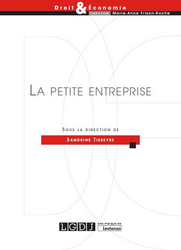
Référence complète : TISSEYRE., Sandrine, (dir.), La petite entreprise, coll. "Droit et Économie", LGDJ - Lextenso éditions, 2017, 220 p.
Il s'agit du 30ième volume paru dans cette collection.
Bien que constituant une réalité économique indéniable, la petite entreprise ne fait l'objet d'aucune reconnaissance juridique globale, et de ce fait est privée d'un régime propre et cohérent. D'aucuns peuvent le justifier par le caractère très divers des structures économiques appréhendées par le vocable " petite entreprise", lequel d'ailleurs n'emporte pas un consensus.
Pour autant que la petite entreprise embrasse des manifestations plurielles, nombre de petits entrepreneurs sont confrontés à des questions similaires, que celles-ci interviennent en amont sur le choix de la structure à retenir, ou qu'elles s’apparentent aux régimes fiscal, comptable, social qui s'appliqueront à l'entreprise.
L'ouvrage a pour ambition de répondre à différentes interrogations, qui font l'objet d'un intérêt grandissant, et de proposer des pistes de réflexion et d'amélioration du droit positif: la petite entreprise mérite-t-elle une reconnaissance autonome? Le droit actuel est-il adapté à la petite entreprise? Serait-il opportun de reconnaître un statut spécifique aux petites structures aux petites structures, et le cas échéant quels en seraient les contours?
Lire la quatrième de couverture.
Consulter l'ensemble de la collection dans laquelle l'ouvrage a été publié.
Aug. 23, 2014
Editorial responsibilities : Direction of the collection "Cours-Série Droit privé", Editions Dalloz (33)
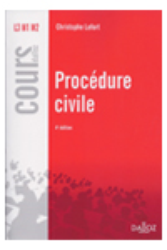
This "course", the 5th edition just out, shows how civil procedure is a major discipline of private law insofar as it contributes to realize the rights of persons. The procedure is the law of the civil trial, it organizes it.
This manual explains in the first part, the principles that govern individual right granted to a litigant access to a judge. In the second part, it details the main mechanisms that govern the conduct of civil cases.
Primarily designed for the attention of undergraduate and master, this book will also interest those who are eager to know and understand the progress of the civil trial.
Feb. 12, 2014
Editorial responsibilities : Direction of the collection "Cours-Série Droit privé", Editions Dalloz (33)
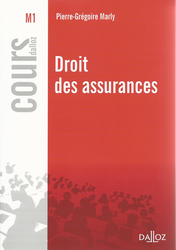
Pour lire la 4ième de couverture, cliquez ici.
Pour lire les prolégomènes, cliquez ici.
Pour lire la table des matières, cliquez ici.
Dec. 9, 2013
Editorial responsibilities : Direction de la collection "Droit et Économie", L.G.D.J. - Lextenso éditions (30)
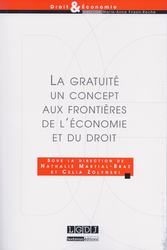
Référence complète : N. Martial-Braz et Célia Zolynski (dir.), La gratuité : un concept aux frontières de l'économie et du droit, coll. "Droit et Économie", L.G.D.J. - Lextenso éditions, 2013, 282 p.
Il s'agit du 21ième volume publié dans la collection "Droit et Économie".
Lire la quatrième de couverture.
Consulter l'ensemble des ouvrages parus dans la Collection.
June 13, 2012
Editorial responsibilities : Direction de la collection "Droit et Économie", L.G.D.J. - Lextenso éditions (30)
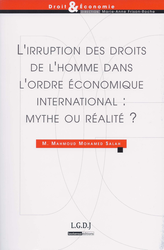
Référence complète : SALAH, M. Mahmoud Mohamed, L'irruption des droits de l'homme dans l'ordre économique international : mythe ou réalité, coll. "Droit et Économie", L.G.D.J- Lextenso éditions, 2012, 302 p.
Il s'agit du 18ième volume paru dans la collection "Droit et Économie".
Consulter l'ensemble de la collection dans laquelle l'ouvrage a été publié.
June 13, 2012
Editorial responsibilities : Direction de la collection "Droit et Économie", L.G.D.J. - Lextenso éditions (30)

Référence complète : SALAH, M. Mahmoud Mohamed, L'irruption des droits de l'homme dans l'ordre économique international : mythe ou réalité, coll. "Droit et Économie", L.G.D.J- Lextenso éditions, 2012, 302 p.
Il s'agit du 18ième volume paru dans la collection "Droit et Économie".
Consulter l'ensemble de la collection dans laquelle l'ouvrage a été publié.